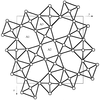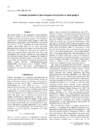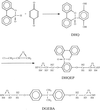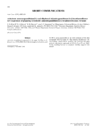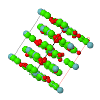issue contents
August 1999 issue

Cover illustration: An infinite hydrogen-bonded sheet in guanidinium trifluoromethanesulfonate. Courtesy of C. B. Aakeröy [Acta Cryst. (1997), B53, 569-586; structure determined by V. A. Russell, M. C. Etter & M. D. Ward].
research papers
Download citation


Download citation


The paraelectric phase of Pb2KNb5O15 has a tetragonal tungsten-bronze-like structure above the Curie temperature (TC = 730 K). Below TC the structure is slightly distorted (orthorhombic) and the phase is both ferroelectric and ferroelastic. A structural study of both phases by X-ray and neutron powder diffraction is presented.
Download citation


Download citation


The modulated structures of three crystals of EuVxMo8±yO14 with different compositions and different modulation waves are studied and compared. The action of the modulation on the distribution and the geometry of the different types of metallic clusters is also studied. Evidence is presented for new types of Mo9 and Mo10 metallic clusters, formed by capping three or four faces of the octahedral Mo6 units, and strong metallic bonds between the clusters are implied in some unit cells of the three crystals.
Investigation of the relative stability of the FeSi structure and of some hypothetical polymorphs by first-principles pseudopotential calculations has shown that the observed distortion of the FeSi structure from its idealized form is essential for its stability. It is predicted that FeSi having a CsCl-type structure will be the thermodynamically most stable phase for pressures greater than 13 GPa.
Approximately 40% of the crystal structures in point group 4 of the current release of the Inorganic Crystal Structure Database are found to satisfy the structural criteria for potential ferroelectricity. Each prediction of ferroelectricity is associated with a probable phase transition, not all of which are necessarily subgroup–supergroup transitions.
The stacking sequences of long-period polytypes (including a mixed-rotation 36-layer polytype) of oxybiotite mica have been unambiguously determined by the combination of atomic resolution images recorded down two zone axes and periodic intensity distributions in electron diffraction patterns using TEM.
Download citation


Download citation


The polarizing effect of the small lithium cations determines the crystal structures of three lithium halogenoacetates and is most likely responsible for the absence of the solid-state polymerizability that is found for most other halogenoacetates.
Download citation


Download citation


The crystal structure of novel 10-[2,5-bis(2,3-epoxy-1-propoxy)phenyl]-9-oxa-10-phosphaphenanthren-10-one has been studied by single-crystal X-ray diffraction. The NMR chemical shifts of the protons of the glycidyl group close to the aryl phosphinate group are reduced by the `ring-current effect'.
Download citation


Download citation


4,5-Dichlorophthalic anhydride (CPA), 5,6-dichlorobenzfurazan 1-oxide (CBF) and 4,5-dibromophthalic anhydride (BPA) are approximately isosteric. CBF has three polymorphic forms. Polymorph A of CBF is isomorphous with CPA. Polymorph C of CBF and BPA are both pseudo-isomorphous with CPA, but in different ways.
The crystal structures of two polymorphs of the title compound are analyzed by packing energy criteria. Other unobserved polymorphic crystal structures are generated using a polymorph predictor package and three different force fields, one of which is without explicit Coulomb-type terms. The X-ray structure of the  polymorph was found to be among the most stable ones by the polymorph predictor, even using the chargeless force field.
polymorph was found to be among the most stable ones by the polymorph predictor, even using the chargeless force field.
Download citation


Download citation


The unknown crystal and molecular structures of two organic compounds have been determined from X-ray, synchrotron and neutron powder diffraction data using various methods. The results obtained demonstrate the high level of reproducibility and reliability of various powder software and equipment.
Topological analysis of the electron density at the hydrogen bond critical point (CP) on a large number of crystals studied by experimental [X − X and X − (X + N)] methods has been investigated. A new classification of the hydrogen bond is proposed involving the λ3 electron density curvature along the bonding direction.
Download citation


Download citation


The 2:1 adduct of 4,4′-sulfonyldiphenol and pyrazine takes the form of continuously interwoven molecular ladders; the 1:1 adducts of 4,4′-sulfonyldiphenol with 4,4′-bipyridyl, 1,2-bis(4-pyridyl)ethene, 1,2-bis(4-pyridyl)ethane and 4,4′-trimethylenedipyridine all consist of chains, further cross-linked by C—H⋯O hydrogen bonds. The aquated adduct with 4,4′-trimethylenedipiperidine is a salt in which the components form a hydrogen-bonded three-dimensional framework.
Download citation


Download citation


In its 1:1 adduct with 4,4′-biphenol, 1,10-phenanthroline act as a builder of hydrogen-bonded chains; in its 1:2 adduct with 4,4′-thiodiphenol the diamine acts as a terminator of such chains, and in its 2:3 adduct with 4,4′-sulfonyldiphenol, both roles are manifest. In the methanol-solvated 1:1:1 adduct with 1,1,1-tris(4-hydroxyphenyl)ethane the 1,10-phenanthroline units act as chain terminators and the structure contains pairwise-interwoven nets.
Download citation


Download citation


A synchrotron radiation study has been carried out on a single crystal of dimensions 12 × 10 × 2 µm of the organic superconductor βCO-(BEDT-TTF)2I3. The triiodide site population deviates slightly from unity and the conformations and occupancies of the disordered ethylene groups have been determined.
Download citation


Download citation


A mixture of stereoisomers can be misinterpreted as a disordered centrosymmetric structure, but only the ordered structure in a chiral space group is consistent with the anomalous dispersion and chemical evidence.
Download citation


Download citation


A mediated three-centre hydrogen bond is one of the packing motifs involving the α-hydroxycarbonyl moiety in (R,R)-tartaric acid and (R,R)-N-methyltartramic acid monohydrate. The stability of such bonding in model complexes is studied via theoretical calculations.
short communications
An error in printing in the paper by Ross et al. [Acta Cryst. (1999), B55, 246–254] is reported.


 journal menu
journal menu











